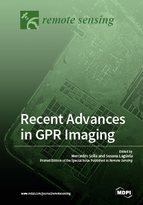Recent Advances in GPR Imaging
A special issue of Remote Sensing (ISSN 2072-4292).
Deadline for manuscript submissions: closed (15 February 2018) | Viewed by 62063
Special Issue Editors
Interests: ground penetrating radar; signal processing; numerical modeling; civil and environmental engineering; cultural heritage; archaeology; geographic information systems (GIS)
Special Issues, Collections and Topics in MDPI journals
Interests: infrared thermography; laser scanning; ground-penetrating radar; 3D modeling; civil and environmental engineering; geographic information systems
Special Issues, Collections and Topics in MDPI journals
Special Issue Information
Dear Colleagues,
Ground Penetrating Radar (GPR) is a close-range remote sensing and non-invasive geophysical technique that uses electromagnetic pulses to detect buried features and to identify their main geometric and physical properties. The GPR method has been quite commonly employed to provide high-resolution imaging of the subsurface and of buried artifacts, and to assess the inner status of structures.
During the last decades, there have been major advances on the development of GPR array multi-channel systems, airborne platforms and the use of three-dimensional imaging techniques and processing software. Recent trends also show an increasing interest for the development of new signal processing algorithms and modeling. New approaches focused on the combined application of GPR with complementary non-destructive techniques are also recommended for high-resolution prospection.
This Special Issue is mainly dedicated to publishing a selection of papers that provides a comprehensive and up-to-date overview of the state-of-the-art of research activities dealing with the development of GPR technology and its recent advances on imaging in different fields of application. We invite you to submit articles on the following topics:
- Novel developments on GPR systems and antennas
- Air and airborne systems
- New data processing algorithms and electromagnetic modeling
- Advances on imaging approaches and 3D visualization
- GPR surveys of archaeological sites and cultural heritage prospection (monuments, ancient buildings, statues, columns, etc.)
- GPR procedures for civil engineering diagnostics (roads and pavements, bridges, tunnels, etc.)
- GPR applications on environment surveying and natural landscapes
- Mine detection and forensics
- Combined use of GPR and complementary non-destructive techniques
Dr. Mercedes Solla
Dr. Susana Lagüela
Guest Editors
Manuscript Submission Information
Manuscripts should be submitted online at www.mdpi.com by registering and logging in to this website. Once you are registered, click here to go to the submission form. Manuscripts can be submitted until the deadline. All submissions that pass pre-check are peer-reviewed. Accepted papers will be published continuously in the journal (as soon as accepted) and will be listed together on the special issue website. Research articles, review articles as well as short communications are invited. For planned papers, a title and short abstract (about 100 words) can be sent to the Editorial Office for announcement on this website.
Submitted manuscripts should not have been published previously, nor be under consideration for publication elsewhere (except conference proceedings papers). All manuscripts are thoroughly refereed through a single-blind peer-review process. A guide for authors and other relevant information for submission of manuscripts is available on the Instructions for Authors page. Remote Sensing is an international peer-reviewed open access semimonthly journal published by MDPI.
Please visit the Instructions for Authors page before submitting a manuscript. The Article Processing Charge (APC) for publication in this open access journal is 2700 CHF (Swiss Francs). Submitted papers should be well formatted and use good English. Authors may use MDPI's English editing service prior to publication or during author revisions.







